Criminogenic Factors and Early Childhood Environment
VerifiedAdded on 2019/12/03
|8
|2925
|379
Essay
AI Summary
The article discusses the impact of family environment and upbringing on children's personality traits, which in turn affect their criminal behavior in later years. It highlights that parents who are not educated can influence their children to engage in anti-social factors, leading to poor supervision and monitoring. Unemployment also enhances juvenile participation in crime by disrupting parenting processes. The study concludes that early childhood experiences shape an individual's personality, making it crucial for appropriate assistance during this period to promote good upbringing.
Contribute Materials
Your contribution can guide someone’s learning journey. Share your
documents today.
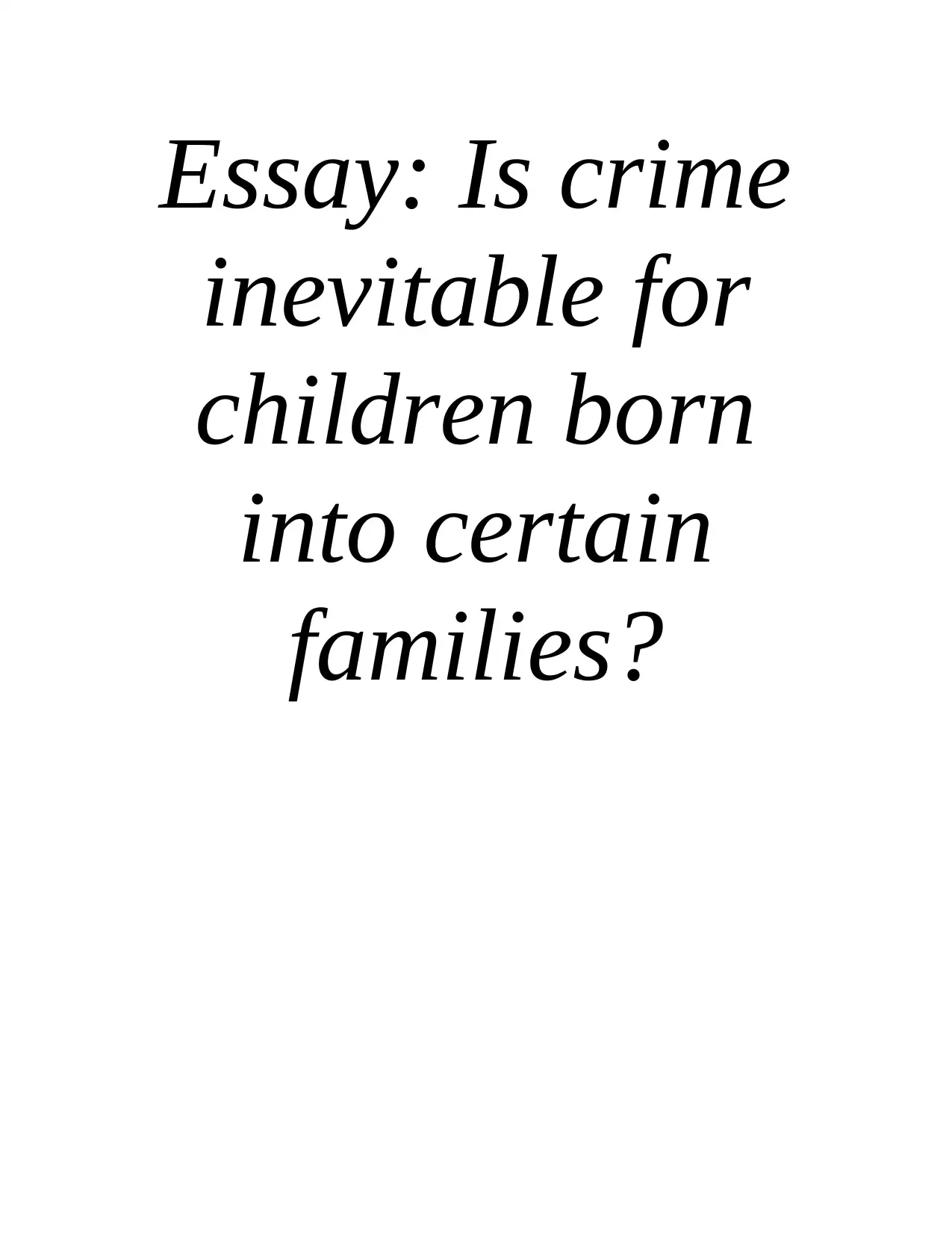
Essay: Is crime
inevitable for
children born
into certain
families?
inevitable for
children born
into certain
families?
Secure Best Marks with AI Grader
Need help grading? Try our AI Grader for instant feedback on your assignments.
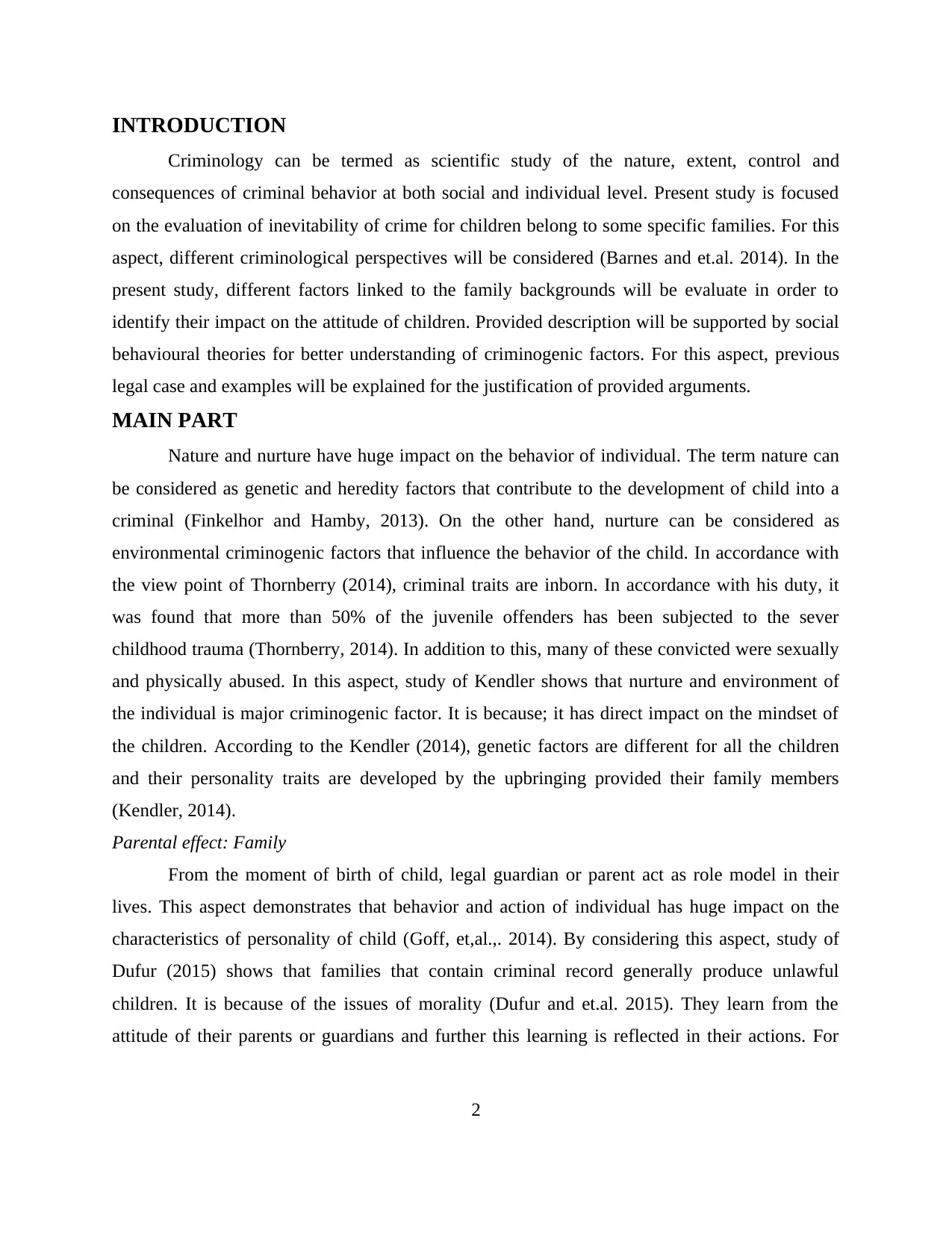
INTRODUCTION
Criminology can be termed as scientific study of the nature, extent, control and
consequences of criminal behavior at both social and individual level. Present study is focused
on the evaluation of inevitability of crime for children belong to some specific families. For this
aspect, different criminological perspectives will be considered (Barnes and et.al. 2014). In the
present study, different factors linked to the family backgrounds will be evaluate in order to
identify their impact on the attitude of children. Provided description will be supported by social
behavioural theories for better understanding of criminogenic factors. For this aspect, previous
legal case and examples will be explained for the justification of provided arguments.
MAIN PART
Nature and nurture have huge impact on the behavior of individual. The term nature can
be considered as genetic and heredity factors that contribute to the development of child into a
criminal (Finkelhor and Hamby, 2013). On the other hand, nurture can be considered as
environmental criminogenic factors that influence the behavior of the child. In accordance with
the view point of Thornberry (2014), criminal traits are inborn. In accordance with his duty, it
was found that more than 50% of the juvenile offenders has been subjected to the sever
childhood trauma (Thornberry, 2014). In addition to this, many of these convicted were sexually
and physically abused. In this aspect, study of Kendler shows that nurture and environment of
the individual is major criminogenic factor. It is because; it has direct impact on the mindset of
the children. According to the Kendler (2014), genetic factors are different for all the children
and their personality traits are developed by the upbringing provided their family members
(Kendler, 2014).
Parental effect: Family
From the moment of birth of child, legal guardian or parent act as role model in their
lives. This aspect demonstrates that behavior and action of individual has huge impact on the
characteristics of personality of child (Goff, et,al.,. 2014). By considering this aspect, study of
Dufur (2015) shows that families that contain criminal record generally produce unlawful
children. It is because of the issues of morality (Dufur and et.al. 2015). They learn from the
attitude of their parents or guardians and further this learning is reflected in their actions. For
2
Criminology can be termed as scientific study of the nature, extent, control and
consequences of criminal behavior at both social and individual level. Present study is focused
on the evaluation of inevitability of crime for children belong to some specific families. For this
aspect, different criminological perspectives will be considered (Barnes and et.al. 2014). In the
present study, different factors linked to the family backgrounds will be evaluate in order to
identify their impact on the attitude of children. Provided description will be supported by social
behavioural theories for better understanding of criminogenic factors. For this aspect, previous
legal case and examples will be explained for the justification of provided arguments.
MAIN PART
Nature and nurture have huge impact on the behavior of individual. The term nature can
be considered as genetic and heredity factors that contribute to the development of child into a
criminal (Finkelhor and Hamby, 2013). On the other hand, nurture can be considered as
environmental criminogenic factors that influence the behavior of the child. In accordance with
the view point of Thornberry (2014), criminal traits are inborn. In accordance with his duty, it
was found that more than 50% of the juvenile offenders has been subjected to the sever
childhood trauma (Thornberry, 2014). In addition to this, many of these convicted were sexually
and physically abused. In this aspect, study of Kendler shows that nurture and environment of
the individual is major criminogenic factor. It is because; it has direct impact on the mindset of
the children. According to the Kendler (2014), genetic factors are different for all the children
and their personality traits are developed by the upbringing provided their family members
(Kendler, 2014).
Parental effect: Family
From the moment of birth of child, legal guardian or parent act as role model in their
lives. This aspect demonstrates that behavior and action of individual has huge impact on the
characteristics of personality of child (Goff, et,al.,. 2014). By considering this aspect, study of
Dufur (2015) shows that families that contain criminal record generally produce unlawful
children. It is because of the issues of morality (Dufur and et.al. 2015). They learn from the
attitude of their parents or guardians and further this learning is reflected in their actions. For
2
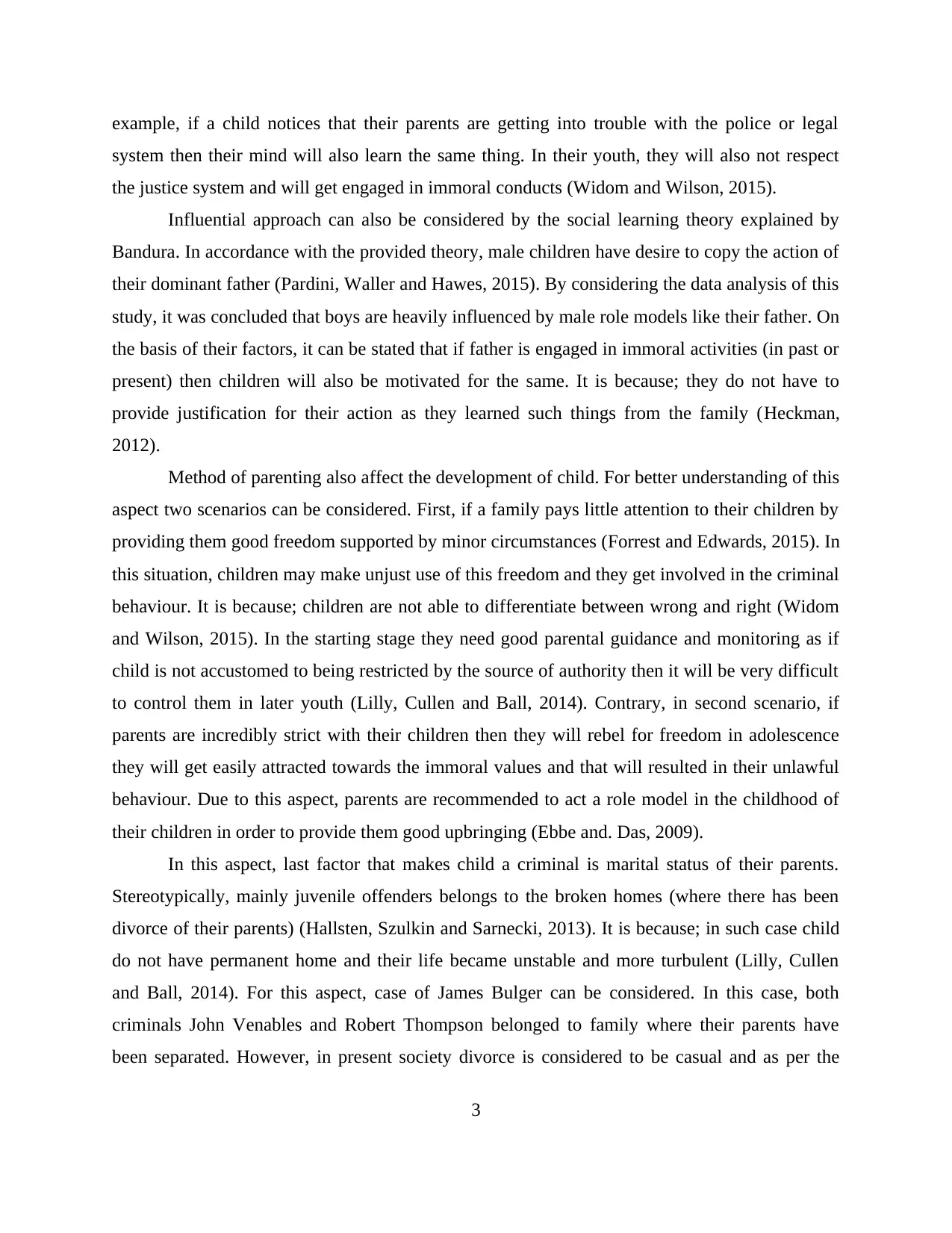
example, if a child notices that their parents are getting into trouble with the police or legal
system then their mind will also learn the same thing. In their youth, they will also not respect
the justice system and will get engaged in immoral conducts (Widom and Wilson, 2015).
Influential approach can also be considered by the social learning theory explained by
Bandura. In accordance with the provided theory, male children have desire to copy the action of
their dominant father (Pardini, Waller and Hawes, 2015). By considering the data analysis of this
study, it was concluded that boys are heavily influenced by male role models like their father. On
the basis of their factors, it can be stated that if father is engaged in immoral activities (in past or
present) then children will also be motivated for the same. It is because; they do not have to
provide justification for their action as they learned such things from the family (Heckman,
2012).
Method of parenting also affect the development of child. For better understanding of this
aspect two scenarios can be considered. First, if a family pays little attention to their children by
providing them good freedom supported by minor circumstances (Forrest and Edwards, 2015). In
this situation, children may make unjust use of this freedom and they get involved in the criminal
behaviour. It is because; children are not able to differentiate between wrong and right (Widom
and Wilson, 2015). In the starting stage they need good parental guidance and monitoring as if
child is not accustomed to being restricted by the source of authority then it will be very difficult
to control them in later youth (Lilly, Cullen and Ball, 2014). Contrary, in second scenario, if
parents are incredibly strict with their children then they will rebel for freedom in adolescence
they will get easily attracted towards the immoral values and that will resulted in their unlawful
behaviour. Due to this aspect, parents are recommended to act a role model in the childhood of
their children in order to provide them good upbringing (Ebbe and. Das, 2009).
In this aspect, last factor that makes child a criminal is marital status of their parents.
Stereotypically, mainly juvenile offenders belongs to the broken homes (where there has been
divorce of their parents) (Hallsten, Szulkin and Sarnecki, 2013). It is because; in such case child
do not have permanent home and their life became unstable and more turbulent (Lilly, Cullen
and Ball, 2014). For this aspect, case of James Bulger can be considered. In this case, both
criminals John Venables and Robert Thompson belonged to family where their parents have
been separated. However, in present society divorce is considered to be casual and as per the
3
system then their mind will also learn the same thing. In their youth, they will also not respect
the justice system and will get engaged in immoral conducts (Widom and Wilson, 2015).
Influential approach can also be considered by the social learning theory explained by
Bandura. In accordance with the provided theory, male children have desire to copy the action of
their dominant father (Pardini, Waller and Hawes, 2015). By considering the data analysis of this
study, it was concluded that boys are heavily influenced by male role models like their father. On
the basis of their factors, it can be stated that if father is engaged in immoral activities (in past or
present) then children will also be motivated for the same. It is because; they do not have to
provide justification for their action as they learned such things from the family (Heckman,
2012).
Method of parenting also affect the development of child. For better understanding of this
aspect two scenarios can be considered. First, if a family pays little attention to their children by
providing them good freedom supported by minor circumstances (Forrest and Edwards, 2015). In
this situation, children may make unjust use of this freedom and they get involved in the criminal
behaviour. It is because; children are not able to differentiate between wrong and right (Widom
and Wilson, 2015). In the starting stage they need good parental guidance and monitoring as if
child is not accustomed to being restricted by the source of authority then it will be very difficult
to control them in later youth (Lilly, Cullen and Ball, 2014). Contrary, in second scenario, if
parents are incredibly strict with their children then they will rebel for freedom in adolescence
they will get easily attracted towards the immoral values and that will resulted in their unlawful
behaviour. Due to this aspect, parents are recommended to act a role model in the childhood of
their children in order to provide them good upbringing (Ebbe and. Das, 2009).
In this aspect, last factor that makes child a criminal is marital status of their parents.
Stereotypically, mainly juvenile offenders belongs to the broken homes (where there has been
divorce of their parents) (Hallsten, Szulkin and Sarnecki, 2013). It is because; in such case child
do not have permanent home and their life became unstable and more turbulent (Lilly, Cullen
and Ball, 2014). For this aspect, case of James Bulger can be considered. In this case, both
criminals John Venables and Robert Thompson belonged to family where their parents have
been separated. However, in present society divorce is considered to be casual and as per the
3

recent statistics 50% of the marriages end in divorce. By considering this aspect, separation of
parents cannot be treated as prominent criminogenic factor but this factor has cumulative
influence (Schroeder, 2014).
Siblings
Impact of sibling on criminal behavior of children can be considered mainly in two ways
i.e. origins of social learning and aspect of ignorance and attention seeking. In accordance with
the social learning theory, siblings are also role model of children (Cvetkovic and Olson, 2012).
In accordance with the study of Ngo and Paternoster (2014), if elder siblings are involved into
criminal activities then they will also encourage child either in direct or indirect manner (Ngo
and Paternoster, 2014). In some situation, there is peer pressure on young siblings to contribute
in possible criminal behavior. However, some criminologists had argued in this aspect that
younger siblings learn from the mistake of other and it may have positive impact on their
behaviour (Williams and et.al. 2014).
Another manner, through which sibling may influence is aspects of ignorance and
attention seeking. In accordance with the study of Schroeder (2014), siblings have little
individual attention from parents in families having large numbers of children. Due to this factor,
generally they do not have much guidance in their early childhood and adolescence (Schroeder,
2014). This aspect attracts them to outsider world for the fulfilment of desire of attention. Study
of Williams (2014) shows that, some children only get engaged in criminal conduct to capture
the consideration of their parents. In this aspect David Jackson had stated that various children
are jealous of their siblings and for the purpose of revenge or attention they are influenced from
the criminal conduct (Williams and et.al. 2014).
Impact of sexual and physical abuse
As per the study of Fagan (2013), all criminal actions are performed by individuals from
the objective to attain justice or for the removal of justice. In various criminal cases, feeling of
injustice has been originated from the aspect that how child is treated by family members and
friends at their early stage (Fagan, 2013). Prediction made by James Gilligan in this aspect were
accurate as violent behaviour is continued until the point at which trauma is fully addressed.
However, not all children are turned out to be criminal in later age of their life who had suffered
from the victimization and harassment in the childhood (Dufur and et.al. 2015). In addition to
4
parents cannot be treated as prominent criminogenic factor but this factor has cumulative
influence (Schroeder, 2014).
Siblings
Impact of sibling on criminal behavior of children can be considered mainly in two ways
i.e. origins of social learning and aspect of ignorance and attention seeking. In accordance with
the social learning theory, siblings are also role model of children (Cvetkovic and Olson, 2012).
In accordance with the study of Ngo and Paternoster (2014), if elder siblings are involved into
criminal activities then they will also encourage child either in direct or indirect manner (Ngo
and Paternoster, 2014). In some situation, there is peer pressure on young siblings to contribute
in possible criminal behavior. However, some criminologists had argued in this aspect that
younger siblings learn from the mistake of other and it may have positive impact on their
behaviour (Williams and et.al. 2014).
Another manner, through which sibling may influence is aspects of ignorance and
attention seeking. In accordance with the study of Schroeder (2014), siblings have little
individual attention from parents in families having large numbers of children. Due to this factor,
generally they do not have much guidance in their early childhood and adolescence (Schroeder,
2014). This aspect attracts them to outsider world for the fulfilment of desire of attention. Study
of Williams (2014) shows that, some children only get engaged in criminal conduct to capture
the consideration of their parents. In this aspect David Jackson had stated that various children
are jealous of their siblings and for the purpose of revenge or attention they are influenced from
the criminal conduct (Williams and et.al. 2014).
Impact of sexual and physical abuse
As per the study of Fagan (2013), all criminal actions are performed by individuals from
the objective to attain justice or for the removal of justice. In various criminal cases, feeling of
injustice has been originated from the aspect that how child is treated by family members and
friends at their early stage (Fagan, 2013). Prediction made by James Gilligan in this aspect were
accurate as violent behaviour is continued until the point at which trauma is fully addressed.
However, not all children are turned out to be criminal in later age of their life who had suffered
from the victimization and harassment in the childhood (Dufur and et.al. 2015). In addition to
4
Secure Best Marks with AI Grader
Need help grading? Try our AI Grader for instant feedback on your assignments.
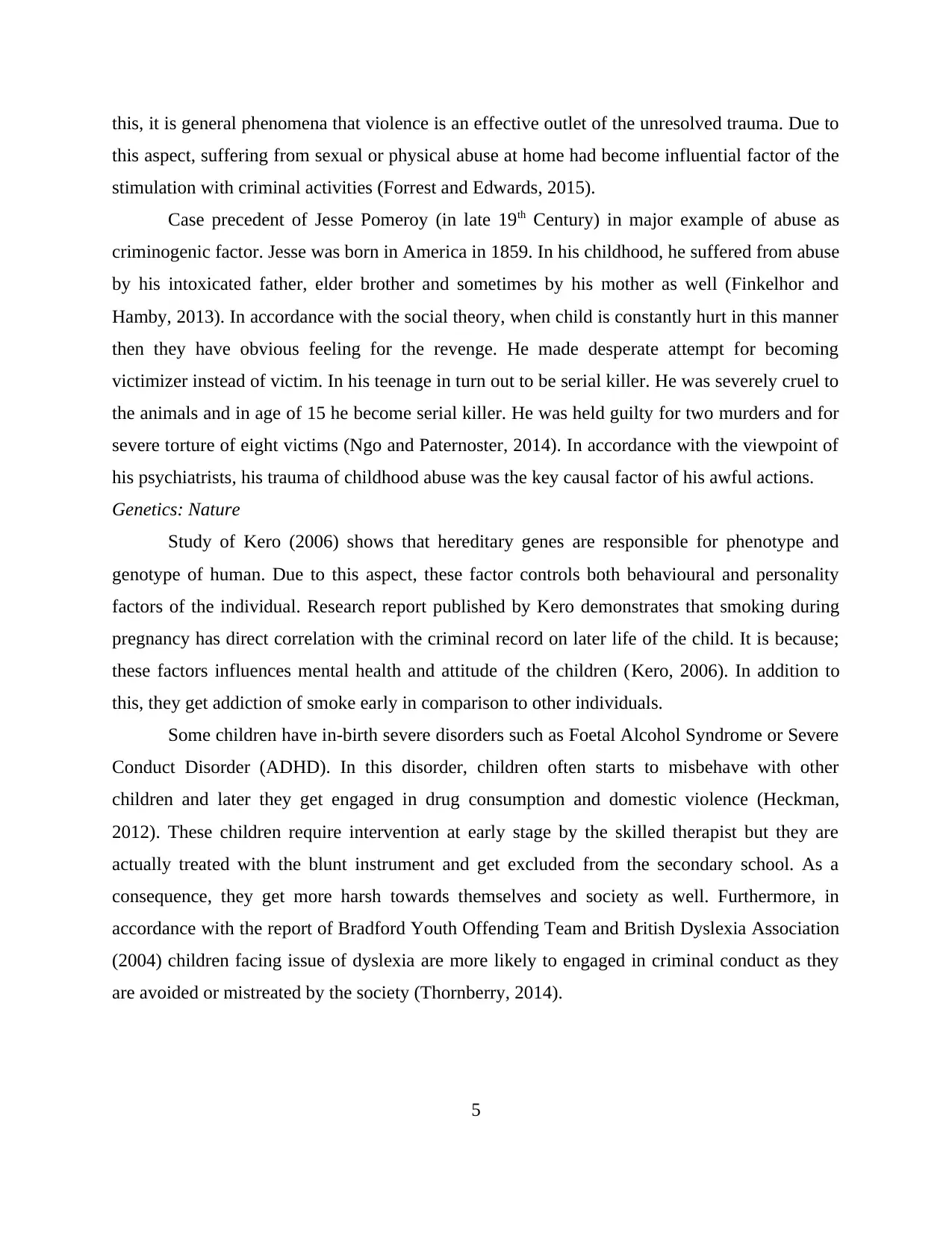
this, it is general phenomena that violence is an effective outlet of the unresolved trauma. Due to
this aspect, suffering from sexual or physical abuse at home had become influential factor of the
stimulation with criminal activities (Forrest and Edwards, 2015).
Case precedent of Jesse Pomeroy (in late 19th Century) in major example of abuse as
criminogenic factor. Jesse was born in America in 1859. In his childhood, he suffered from abuse
by his intoxicated father, elder brother and sometimes by his mother as well (Finkelhor and
Hamby, 2013). In accordance with the social theory, when child is constantly hurt in this manner
then they have obvious feeling for the revenge. He made desperate attempt for becoming
victimizer instead of victim. In his teenage in turn out to be serial killer. He was severely cruel to
the animals and in age of 15 he become serial killer. He was held guilty for two murders and for
severe torture of eight victims (Ngo and Paternoster, 2014). In accordance with the viewpoint of
his psychiatrists, his trauma of childhood abuse was the key causal factor of his awful actions.
Genetics: Nature
Study of Kero (2006) shows that hereditary genes are responsible for phenotype and
genotype of human. Due to this aspect, these factor controls both behavioural and personality
factors of the individual. Research report published by Kero demonstrates that smoking during
pregnancy has direct correlation with the criminal record on later life of the child. It is because;
these factors influences mental health and attitude of the children (Kero, 2006). In addition to
this, they get addiction of smoke early in comparison to other individuals.
Some children have in-birth severe disorders such as Foetal Alcohol Syndrome or Severe
Conduct Disorder (ADHD). In this disorder, children often starts to misbehave with other
children and later they get engaged in drug consumption and domestic violence (Heckman,
2012). These children require intervention at early stage by the skilled therapist but they are
actually treated with the blunt instrument and get excluded from the secondary school. As a
consequence, they get more harsh towards themselves and society as well. Furthermore, in
accordance with the report of Bradford Youth Offending Team and British Dyslexia Association
(2004) children facing issue of dyslexia are more likely to engaged in criminal conduct as they
are avoided or mistreated by the society (Thornberry, 2014).
5
this aspect, suffering from sexual or physical abuse at home had become influential factor of the
stimulation with criminal activities (Forrest and Edwards, 2015).
Case precedent of Jesse Pomeroy (in late 19th Century) in major example of abuse as
criminogenic factor. Jesse was born in America in 1859. In his childhood, he suffered from abuse
by his intoxicated father, elder brother and sometimes by his mother as well (Finkelhor and
Hamby, 2013). In accordance with the social theory, when child is constantly hurt in this manner
then they have obvious feeling for the revenge. He made desperate attempt for becoming
victimizer instead of victim. In his teenage in turn out to be serial killer. He was severely cruel to
the animals and in age of 15 he become serial killer. He was held guilty for two murders and for
severe torture of eight victims (Ngo and Paternoster, 2014). In accordance with the viewpoint of
his psychiatrists, his trauma of childhood abuse was the key causal factor of his awful actions.
Genetics: Nature
Study of Kero (2006) shows that hereditary genes are responsible for phenotype and
genotype of human. Due to this aspect, these factor controls both behavioural and personality
factors of the individual. Research report published by Kero demonstrates that smoking during
pregnancy has direct correlation with the criminal record on later life of the child. It is because;
these factors influences mental health and attitude of the children (Kero, 2006). In addition to
this, they get addiction of smoke early in comparison to other individuals.
Some children have in-birth severe disorders such as Foetal Alcohol Syndrome or Severe
Conduct Disorder (ADHD). In this disorder, children often starts to misbehave with other
children and later they get engaged in drug consumption and domestic violence (Heckman,
2012). These children require intervention at early stage by the skilled therapist but they are
actually treated with the blunt instrument and get excluded from the secondary school. As a
consequence, they get more harsh towards themselves and society as well. Furthermore, in
accordance with the report of Bradford Youth Offending Team and British Dyslexia Association
(2004) children facing issue of dyslexia are more likely to engaged in criminal conduct as they
are avoided or mistreated by the society (Thornberry, 2014).
5

Educational background and employment of family
It is a general phenomenon that family is first school of child. They learn in accordance
with the provided environment by their family and closer outer community such as neighbours.
If parents will be educated, then they will provide ethical and moral values to their children
(Pardini, Waller and Hawes, 2015). In addition to this, from the beginning stage of their life they
will understand their ethical responsibilities towards the society. Furthermore, they will learn to
respect the judicial and social norms. On the contrary situation, if parents are not educated then
their mentality will be affected by this aspect (Forrest and Edwards, 2015). As a consequence,
they will not able to provide good guidance to their children and they will be more attracted
towards the anti-social factors of the society (Goff, et,al.,. 2014). Further, poor supervision and
monitoring allows children to get affected by the aspects of peer pressure. These factors are
general noticed in the behavior of parent of individual who are anti-social.
As per the study of Kendler (2014), unemployment also enhances the juvenile
participation in the crime. It is because; this aspect disrupts the process of parenting and
consequently juveniles are more susceptible to derelict the peer influence. Due to poverty,
sometimes parents take out frustration of their child which have severe adverse impact on their
mind (Kendler, 2014).
CONCLUSION
In accordance with the present study, conclusion can be drawn that nurture and
environment provide to the child in their early years has huge impact on their personality traits.
Inappropriate environment and upbringing influences them to get engaged in criminal conduct in
their youth. However, this factor is not sole reason for the criminal attitude of the individual. It is
because outer environment also influences the behaviour of individual. Although it can be
concluded that the nurture outweighs the nature of the child as criminogenic factor due to which
they get engaged in criminal conduct in later age of their life. By considering this aspect, it can
be said that appropriate assistance in early childhood is vital for the good upbringing of children.
6
It is a general phenomenon that family is first school of child. They learn in accordance
with the provided environment by their family and closer outer community such as neighbours.
If parents will be educated, then they will provide ethical and moral values to their children
(Pardini, Waller and Hawes, 2015). In addition to this, from the beginning stage of their life they
will understand their ethical responsibilities towards the society. Furthermore, they will learn to
respect the judicial and social norms. On the contrary situation, if parents are not educated then
their mentality will be affected by this aspect (Forrest and Edwards, 2015). As a consequence,
they will not able to provide good guidance to their children and they will be more attracted
towards the anti-social factors of the society (Goff, et,al.,. 2014). Further, poor supervision and
monitoring allows children to get affected by the aspects of peer pressure. These factors are
general noticed in the behavior of parent of individual who are anti-social.
As per the study of Kendler (2014), unemployment also enhances the juvenile
participation in the crime. It is because; this aspect disrupts the process of parenting and
consequently juveniles are more susceptible to derelict the peer influence. Due to poverty,
sometimes parents take out frustration of their child which have severe adverse impact on their
mind (Kendler, 2014).
CONCLUSION
In accordance with the present study, conclusion can be drawn that nurture and
environment provide to the child in their early years has huge impact on their personality traits.
Inappropriate environment and upbringing influences them to get engaged in criminal conduct in
their youth. However, this factor is not sole reason for the criminal attitude of the individual. It is
because outer environment also influences the behaviour of individual. Although it can be
concluded that the nurture outweighs the nature of the child as criminogenic factor due to which
they get engaged in criminal conduct in later age of their life. By considering this aspect, it can
be said that appropriate assistance in early childhood is vital for the good upbringing of children.
6
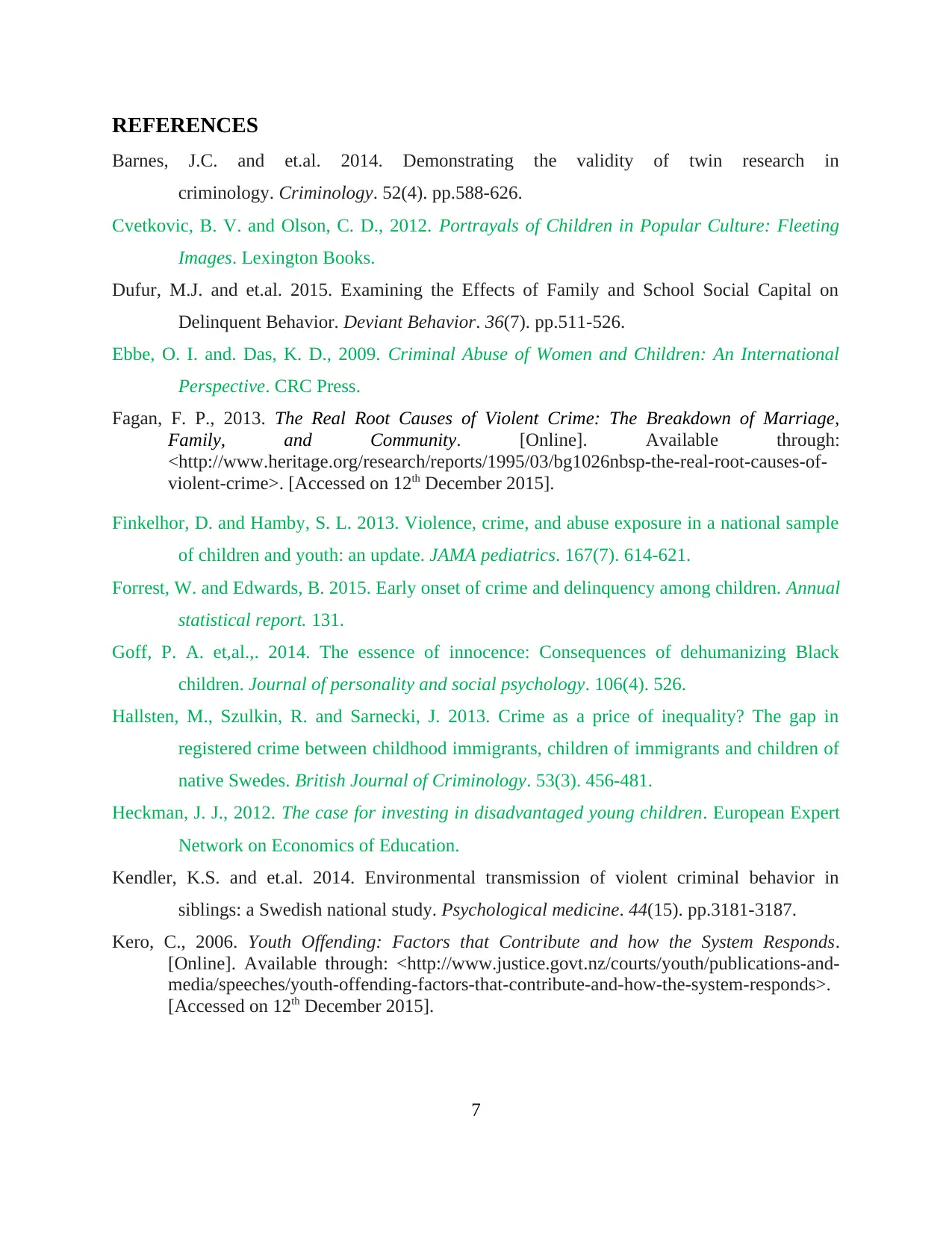
REFERENCES
Barnes, J.C. and et.al. 2014. Demonstrating the validity of twin research in
criminology. Criminology. 52(4). pp.588-626.
Cvetkovic, B. V. and Olson, C. D., 2012. Portrayals of Children in Popular Culture: Fleeting
Images. Lexington Books.
Dufur, M.J. and et.al. 2015. Examining the Effects of Family and School Social Capital on
Delinquent Behavior. Deviant Behavior. 36(7). pp.511-526.
Ebbe, O. I. and. Das, K. D., 2009. Criminal Abuse of Women and Children: An International
Perspective. CRC Press.
Fagan, F. P., 2013. The Real Root Causes of Violent Crime: The Breakdown of Marriage,
Family, and Community. [Online]. Available through:
<http://www.heritage.org/research/reports/1995/03/bg1026nbsp-the-real-root-causes-of-
violent-crime>. [Accessed on 12th December 2015].
Finkelhor, D. and Hamby, S. L. 2013. Violence, crime, and abuse exposure in a national sample
of children and youth: an update. JAMA pediatrics. 167(7). 614-621.
Forrest, W. and Edwards, B. 2015. Early onset of crime and delinquency among children. Annual
statistical report. 131.
Goff, P. A. et,al.,. 2014. The essence of innocence: Consequences of dehumanizing Black
children. Journal of personality and social psychology. 106(4). 526.
Hallsten, M., Szulkin, R. and Sarnecki, J. 2013. Crime as a price of inequality? The gap in
registered crime between childhood immigrants, children of immigrants and children of
native Swedes. British Journal of Criminology. 53(3). 456-481.
Heckman, J. J., 2012. The case for investing in disadvantaged young children. European Expert
Network on Economics of Education.
Kendler, K.S. and et.al. 2014. Environmental transmission of violent criminal behavior in
siblings: a Swedish national study. Psychological medicine. 44(15). pp.3181-3187.
Kero, C., 2006. Youth Offending: Factors that Contribute and how the System Responds.
[Online]. Available through: <http://www.justice.govt.nz/courts/youth/publications-and-
media/speeches/youth-offending-factors-that-contribute-and-how-the-system-responds>.
[Accessed on 12th December 2015].
7
Barnes, J.C. and et.al. 2014. Demonstrating the validity of twin research in
criminology. Criminology. 52(4). pp.588-626.
Cvetkovic, B. V. and Olson, C. D., 2012. Portrayals of Children in Popular Culture: Fleeting
Images. Lexington Books.
Dufur, M.J. and et.al. 2015. Examining the Effects of Family and School Social Capital on
Delinquent Behavior. Deviant Behavior. 36(7). pp.511-526.
Ebbe, O. I. and. Das, K. D., 2009. Criminal Abuse of Women and Children: An International
Perspective. CRC Press.
Fagan, F. P., 2013. The Real Root Causes of Violent Crime: The Breakdown of Marriage,
Family, and Community. [Online]. Available through:
<http://www.heritage.org/research/reports/1995/03/bg1026nbsp-the-real-root-causes-of-
violent-crime>. [Accessed on 12th December 2015].
Finkelhor, D. and Hamby, S. L. 2013. Violence, crime, and abuse exposure in a national sample
of children and youth: an update. JAMA pediatrics. 167(7). 614-621.
Forrest, W. and Edwards, B. 2015. Early onset of crime and delinquency among children. Annual
statistical report. 131.
Goff, P. A. et,al.,. 2014. The essence of innocence: Consequences of dehumanizing Black
children. Journal of personality and social psychology. 106(4). 526.
Hallsten, M., Szulkin, R. and Sarnecki, J. 2013. Crime as a price of inequality? The gap in
registered crime between childhood immigrants, children of immigrants and children of
native Swedes. British Journal of Criminology. 53(3). 456-481.
Heckman, J. J., 2012. The case for investing in disadvantaged young children. European Expert
Network on Economics of Education.
Kendler, K.S. and et.al. 2014. Environmental transmission of violent criminal behavior in
siblings: a Swedish national study. Psychological medicine. 44(15). pp.3181-3187.
Kero, C., 2006. Youth Offending: Factors that Contribute and how the System Responds.
[Online]. Available through: <http://www.justice.govt.nz/courts/youth/publications-and-
media/speeches/youth-offending-factors-that-contribute-and-how-the-system-responds>.
[Accessed on 12th December 2015].
7
Paraphrase This Document
Need a fresh take? Get an instant paraphrase of this document with our AI Paraphraser
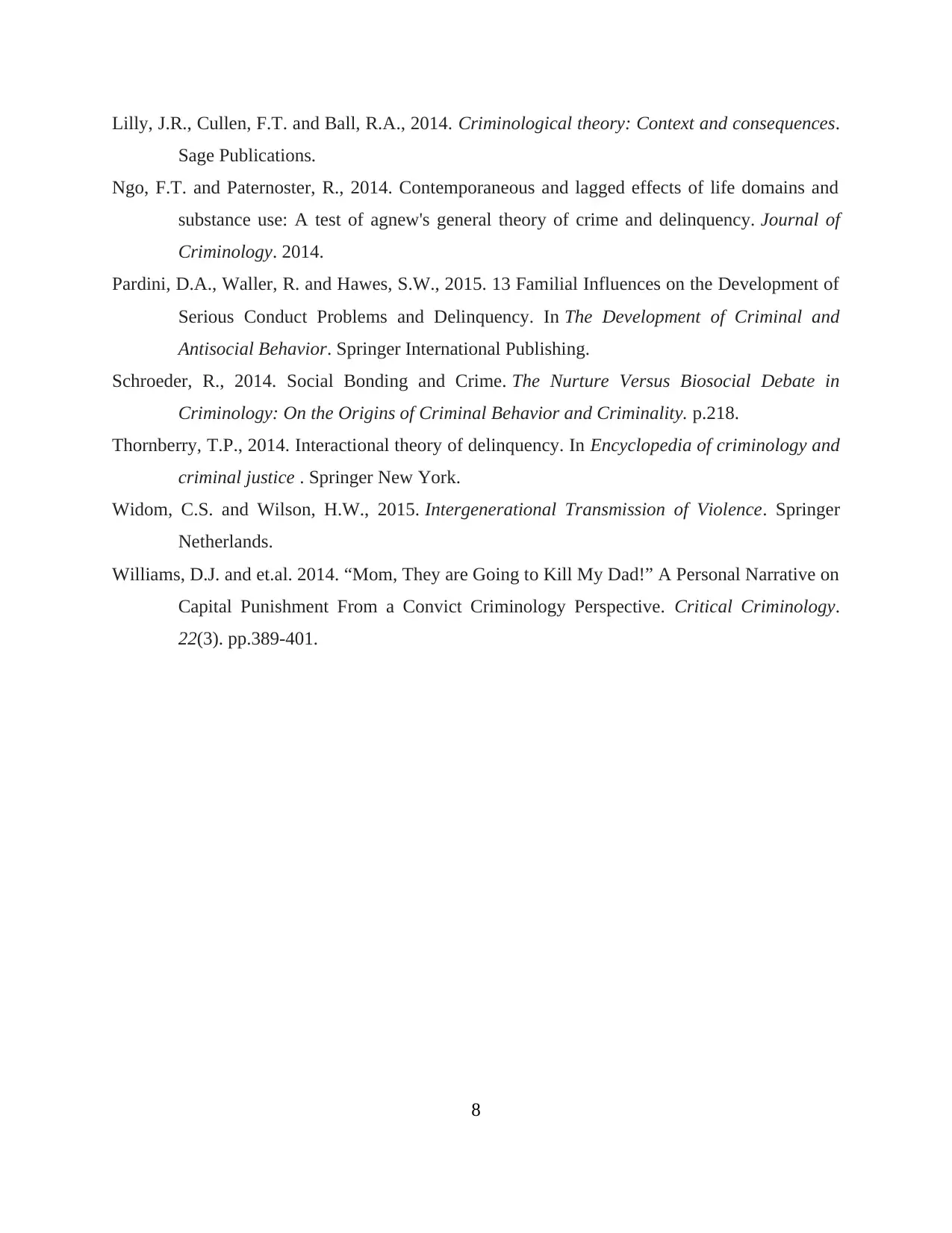
Lilly, J.R., Cullen, F.T. and Ball, R.A., 2014. Criminological theory: Context and consequences.
Sage Publications.
Ngo, F.T. and Paternoster, R., 2014. Contemporaneous and lagged effects of life domains and
substance use: A test of agnew's general theory of crime and delinquency. Journal of
Criminology. 2014.
Pardini, D.A., Waller, R. and Hawes, S.W., 2015. 13 Familial Influences on the Development of
Serious Conduct Problems and Delinquency. In The Development of Criminal and
Antisocial Behavior. Springer International Publishing.
Schroeder, R., 2014. Social Bonding and Crime. The Nurture Versus Biosocial Debate in
Criminology: On the Origins of Criminal Behavior and Criminality. p.218.
Thornberry, T.P., 2014. Interactional theory of delinquency. In Encyclopedia of criminology and
criminal justice . Springer New York.
Widom, C.S. and Wilson, H.W., 2015. Intergenerational Transmission of Violence. Springer
Netherlands.
Williams, D.J. and et.al. 2014. “Mom, They are Going to Kill My Dad!” A Personal Narrative on
Capital Punishment From a Convict Criminology Perspective. Critical Criminology.
22(3). pp.389-401.
8
Sage Publications.
Ngo, F.T. and Paternoster, R., 2014. Contemporaneous and lagged effects of life domains and
substance use: A test of agnew's general theory of crime and delinquency. Journal of
Criminology. 2014.
Pardini, D.A., Waller, R. and Hawes, S.W., 2015. 13 Familial Influences on the Development of
Serious Conduct Problems and Delinquency. In The Development of Criminal and
Antisocial Behavior. Springer International Publishing.
Schroeder, R., 2014. Social Bonding and Crime. The Nurture Versus Biosocial Debate in
Criminology: On the Origins of Criminal Behavior and Criminality. p.218.
Thornberry, T.P., 2014. Interactional theory of delinquency. In Encyclopedia of criminology and
criminal justice . Springer New York.
Widom, C.S. and Wilson, H.W., 2015. Intergenerational Transmission of Violence. Springer
Netherlands.
Williams, D.J. and et.al. 2014. “Mom, They are Going to Kill My Dad!” A Personal Narrative on
Capital Punishment From a Convict Criminology Perspective. Critical Criminology.
22(3). pp.389-401.
8
1 out of 8
Related Documents
Your All-in-One AI-Powered Toolkit for Academic Success.
+13062052269
info@desklib.com
Available 24*7 on WhatsApp / Email
![[object Object]](/_next/static/media/star-bottom.7253800d.svg)
Unlock your academic potential
© 2024 | Zucol Services PVT LTD | All rights reserved.





